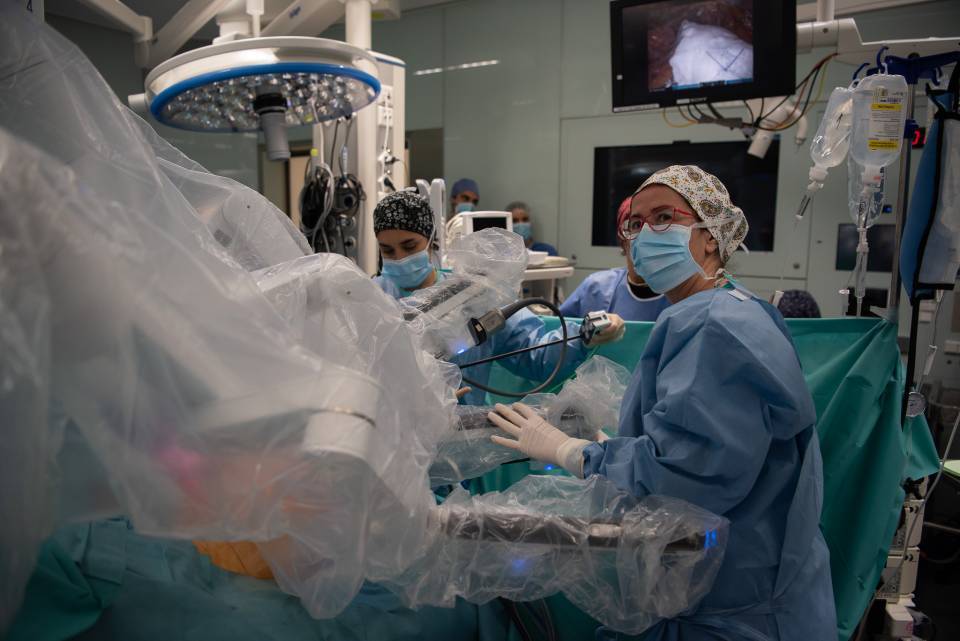Determining the blood flow in the fetal brain and placenta using Doppler in routine third-trimester ultrasound allows for the detection of babies at risk of postpartum complications that may require admission to ICU. Inducing delivery at term in these high-risk cases could potentially reduce the neonatal ICU admission rate by up to half. This is demonstrated by an international multicenter study, named RATIO37, published in The Lancet.
The study, involving various international centers, was conceived and led by Francesc Figueras, Head of the Fetal Medicine Service at the Hospital Clínic de Barcelona (IDIBAPS), and Eduard Gratacós, Director of BCNatal (comprising Hospital Clínic and Hospital Sant Joan de Déu in Barcelona—IDIBAPS and IRSJD). The lead author of the study is Marta Rial Crestelo, from the Fetal and Perinatal Medicine group (IDIBAPS and CIBERER).
Background and Justification of the Study
Less than 1% of babies in low-risk pregnancies experience complications in the last 2-3 weeks of pregnancy or at birth that require admission to the ICU. Severe complications in babies from normal pregnancies are very rare, but when they occur, they are extremely traumatic for families.
A very common cause within this 1% is due to placenta malfunctions towards the end of pregnancy. This situation is known as placental insufficiency and can lead to oxygen deficiency in the baby when uterine contractions occur in late pregnancy and during labor. Detecting cases at risk of placental insufficiency is crucial because it allows for assessing the possibility of ending the pregnancy at full term (37 weeks) and significantly reducing or even avoiding serious complications.
Until now, the detection of this risk has relied on performing an ultrasound at the end of the third trimester to identify babies with low weight, often caused by placental insufficiency. However, this method does not identify all cases of risk. Some babies with normal weight can also have placental insufficiency, but it may have developed late and not led to reduced fetal growth.
A Doppler ultrasound test measuring blood flow in the umbilical cord and brain, called the cerebroplacental ratio (CPR), can detect placental insufficiency. Thus far, this test was only conducted in pregnancies with complications and in very specific cases. For over 10 years, there has been a scientific debate about whether measuring CPR in all pregnancies was necessary or if it was an unnecessary resource expense. If the Doppler test were conducted in all pregnancies, it might improve the detection of babies at risk of complications due to placental insufficiency. However, there was also the risk that the test would not improve anything and instead only result in more expenses and anxiety for mothers.
The RATIO37 study, supported by "la Caixa" Foundation, CEREBRA Foundation, and the Clínic and Sant Joan de Déu Hospitals in Barcelona, aimed to precisely address this question: could we enhance the identification of babies at risk and reduce severe neonatal complications by measuring CPR in all pregnancies?
The research team led by Drs. Francesc Figueras and Eduard Gratacós considered the possibility of extending the study of placental function with CPR to the third-trimester ultrasound of all fetuses, regardless of the estimated fetal weight. "We thought that studying placental function only in low-weight fetuses limited the detection of placental insufficiency, and by extending it to the entire population, we could improve the detection of those babies at risk of needing ICU admission and prevent it through the induction of labor at full term," explained Dr. Figueras.
Multicenter international study RATIO37: Improving the detection of the risk of placental insufficiency
In the RATIO37 study, more than 11,500 women with low-risk pregnancies have participated for six years. At the 36-week ultrasound, CPR was measured in all women, but the participants were randomly divided into two groups. In one group, the test was used to change the management of the pregnancy and if the results were abnormal, early induction of labor was proposed when reaching full term. In the other group, the test results were not communicated, and the pregnancy was managed according to existing protocols. The study compared the number of infant deaths and the occurrence of severe neonatal complications (including, among others, neurological, intestinal, cardiac, renal, or respiratory problems requiring ICU stay for 10 or more days) in each group.
The results demonstrated that there were severe neonatal complications in 0.38% of pregnancies when CPR was measured and 0.73% when it was not measured. It took a study of this magnitude to show a seemingly small difference, but it represents a reduction of 3.5 cases of severe complications per 1000 pregnancies classified as "low risk." If these figures are extrapolated to the total number of births in Spain in 2022 (330,000), it could prevent 1,150 severe neonatal complications.
"The study has shown for the first time that by adding CPR measurement to all fetuses in the third-trimester ultrasound, we could detect those babies at risk of complications requiring ICU admission, regardless of their birth weight. Inducing labor in fetuses showing signs of placental insufficiency allowed for a 50% reduction in complications requiring ICU admission for the newborn," explained Dr. Rial.
“The results are highly relevant; they provide compelling data that will be fundamental in a scientific debate spanning over 10 years and make progress in the development of better ways to refine the detection of high-risk pregnancies and prevent serious neonatal complications. Over the next few years, these results will generate discussions in societies and conferences. The application of these findings in each context will need to be evaluated. However, they will undoubtedly motivate changes in the recommendations of many professional pregnancy control guidelines worldwide," explains Dr. Gratacós.
An additional benefit of the study is that it allows progress towards the goal of being very strict in the selection of cases that benefit from induction of labor. Some international scientific and professional societies support the option of inducing labor at term for nulliparous pregnant women (those who have not had previous births) because it has been shown to reduce severe neonatal complications without worsening the cesarean section rate. However, this would entail inducing labor in half of the pregnant women. This study demonstrates that it is possible to identify much more selectively, specifically 5% of pregnancies that truly benefit from a measure like labor induction, representing an advance towards personalized and minimally invasive maternal-fetal medicine.
The study was carried out in 6 different countries and involved the collaboration of various centers and international leaders, including the University of Palacky, Olomouc, Czech Republic (Marek Lubusky); Institute for the Care of Women and Children, Prague, Czech Republic (Ladislav Krofta); University Hospital Hradec, Kralove, Czech Republic (Marian Kacerovsky); Santa Sofia Hospital, Warsaw, Poland (Anna Kajdy); Soursaky Medical Center, Tel Aviv, Israel (Eyal Zohav); University Hospital of Santiago, Chile (Mauro Parra Cordero); Hospital del Mar, Barcelona (Elena Ferriols Pérez); and Hospital of Specialties for Children and Women, Querétaro, Mexico (Rogelio Cruz).
Reference of the article:
Marta Rial-Crestelo, et al. Term planned delivery based on fetal growth assessment with or without the cerebroplacental ratio in low-risk pregnancies (RATIO37): an international, multicentre, openlabel, randomised controlled trial. The Lancet. January 11, 2024. DOI:https://doi.org/10.1016/S0140-6736(23)02228-60




